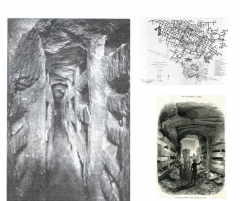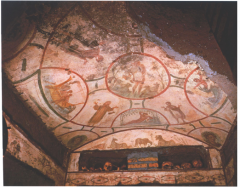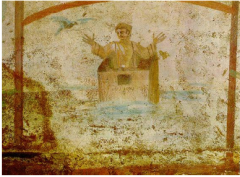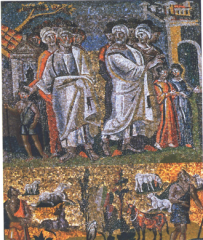![]()
![]()
![]()
Use LEFT and RIGHT arrow keys to navigate between flashcards;
Use UP and DOWN arrow keys to flip the card;
H to show hint;
A reads text to speech;
57 Cards in this Set
- Front
- Back

|
west wall of sanctuary of Dura Europos Synagogue
Dura Europos, Syria tempera on plaster Early Jewish Art 245-246 ce • fresco wall, 4 registers of tempera • unusual because generally, Jews didn't think it was appropriate to illustrate sacred text. This art is the most extensive figural early Jewish art to survive. • Torah kept in center crevice |
|

|
Consecration of Tabernacle and its Priests, detail of west wall of sanctuary of Dura Europos Synagogue (Syria)
tempera on plaster Early Jewish Art 245-246 ce • hieratic style- defies sense of proportion, what is bigger is more important • position of composition is also important, especially what lies on central axis • candelabra on bilateral symmetry, clearly very impt and resembles actual nicht where candelabra would go in the synagogue • the ritual being performed is timeless and recurring • we can read the details (animals, people, cult objects, buildings), but their relationship to each other is unclear- no action, no story that we can make sense of, but the synagogue members most definitely could |
|

|
floor mosaic from Hammath Tiberius Synagogue
Hammath Tiberias, Israel Early Jewish Art 4th century ce • hieratic style • signs of the zodiac around a wheel • Helios, Greek sun god in center • Torah shrine above zodiac with ritual objects • reminiscent of Roman mosaic work |
|

|
The Catacombs
Rome 2nd-5th century ce • cemeteries from both Pagan and Christian Rome, underground • extend for miles, many hidden spaces/crevices with bodies lodged in • very important for early Christian art, holds many frescoes and wall paintings |
|

|
Frescoed ceiling vault from a catacomb with Good Shepherd, Jonah, & Orants.
Early Christian aRT fresco Rome 4th century • elaborate, fixed borders, central circle contains shepherd figure with lamb (allusion to Christ) • style reflects Roman murals but is less grounded in natural observation • where many people might visit the deceased and celebrate the anniversary of their birth with a meal • goal was to be buried within the proximity of a Christian martyr because these people would automatically go to Heaven |
|

|
Sarcophagus
marble 270 ce early Christian art Rome • Used by Christians who could afford a sarcophagus as opposed to just being put on a shelf in catacombs • "apology" - teaching through the use of image • This imagery tells the story of Jonah, the good shepherd (known by Christians and Pagans alike. Pagans knew him as Hermes) • also displays image of baptism • face of woman & philosopher were left uncarved so that portraits of the dead could be added. Usually though, people just bought the sarcophagus and didn't bother adding the faces. |
|

|
image from catacomb of Noah's Ark
fresco 4th century Early Christian art • box symbolizes Ark, Noah has hands out in prayer • image symbolizes salvation and rebirth and baptism through the water |
|

|
image from catacomb of Good Shepherd
fresco 4th century Early Christian art |
|

|
St. Peter's Basilica (reconstruction)
Rome 330 ce • greatest Constantinian church • large but not particularly impressive • open beam ceiling resting on thin walls with columns • kind of flimsy but survived over 1000 years • interior was meant for worship and actual ceremonies, as opposed to pagan traditions such as blood sacrifices which were done outside of the temple. Christian sacrifices didn't involve blood, but rather wine/bread • meant as a martyrium for St. Peter who was buried there |
|

|
Santa Costanza Mausoluem
Rome 350 bce • central plan church, based on circle/octagon rather than longitudinal axis (basilica) • Costanza was supposedly daughter of Constantine • began as funeral chapel, alter in center • walkway around alter • arcade (Series of arches) in center • dome at top • concrete faced with brick (very Roman) • Corinthian ordered capitals, 12 pairs of columns support the dome • narthex (porch) • lacks a choir, so was never very popular because focuses its attention on the worshippers and not the clergy • associated with funerary functions, built over a catacomb |
|

|
early Christian ivories
4th century ivory Early Christian art • intended as book covers • both show image of Christ escaping from tomb, iconographic style • by 400, it became acceptable to visually depict Gods as long as he resembled the human form |
|

|
Ravenna
Mausoleum of Galla Placidia interior- mosaic 425-450 • central plan takes the form of Greek cross • Galla Placidia was one of the last Roman empresses in the west, died at the end of the 5th century • Ravenna is an art center, where many beautiful mosaic wall art pieces have survived |
|

|
image of Christ as the Good Shepherd
from Galla Placidia Mausoleum wall mosaic Early Christian art 425-450 • fully realized landscape • gold robe, purple robes = royal stature • hieratic style • beginning of the notion of a religious icon |
|

|
Basilica of Santa Maria Maggiore
Rome 432-440 • first church dedicated to Mary • columnar Basilica- interior columns support a wall which supports a beamed ceiling • triumphal arch in center of shot depicts stories of the New Testament |
|

|
Painting of "Lot & Abraham" and "Shepherd in a Landscape"
Mosaic Early Christian art from Basilica of Santa Maria Maggiore 432-440 • Abraham and family depart for the land of Canaan • reverse perspective: small figures are in front and the large ones in back. (only really possible using hieratic style) • the narrative symbolizes separation of church & synagogue • figures are shown in broad colors, reminiscent of Pompeiian wall painting |
|

|
Triumphal Arch.
432-440 from Basilica of Santa Maria Maggiore Rome • traditional Roman symbol, an attempt to recover Rome's glory |
|

|
Miniature from "Codex Vergilius Romanus" / "Vatican Vergil"
early 5th century early Christian art parchment • A window into another world- use of deep space, perspective, & play of light and shade • another attempt to recover Roman glory • classical poetry written on manuscript paper • from a book that was bound on one side, unconventional (usually from scroll) |
|

|
Sarcophagus of Junius Bassus
359 ce early Christian art Marble • Junius Bassus was a mayor of Rome • the sarcophagus is dated in inscription • high relief • depicts many small episodes/ sacred images to reveal greater truths (Peter & Paul in Heaven with Christ, Peter & Paul becoming martyrs, Abraham sacrificing Isaac, Adam & Eve, Jobe & his daughters, Christ entering Jerusalem on ass) • elements of Classicism |
|

|
Church of San Vitale
Ravenna 526-547 Early Byzantine style • byzantine building • large windows on every level • decorative walls seem to pulsate • octagonal plan with radiating chapels • interior view is looking toward sanctuary, marbled veneer • visitors are forced to change axis of the building in order to enter, very disorienting |
|

|
Emperor Justinian and his Attendants
mosaic from Church of San Vitale (Ravenna) 547 Early Byzantine Style • tension between reality and the depiction of the art: in the piece of art, the emperor is in middle but, generally, the person holding the sacred book always led the procession. • dramatic action • feet seem to be dangling and not completely on the ground, done on purpose to show an other-worldliness in the figures |
|

|
Empress Theodors and Her Attendants
mosaic from Church of San Vitale (Ravenna) 547 Early Byzantine style • she is very much a Byzantine empress (crown, pearls) z8 sacred curtain and fountain are depicted |
|

|
Ex-Church of Hagia Sophia
architects: Anthemius & Isodorus 532-537 Istanbul, Turkey Early Byzantine style • looks like a mountain from the outside, dome is ~100 feet in diameter • interior is dazzling, covered in gold mosaics • dome sits on pendentives- 4 arches arranged on a square and support the dome on top • depiction of lower part of architecture & floor: marbled veneer • dome on pendentives (first example of this) • first dome fell / Was turned into a mosque in 1400's, now a museum • light through windows plays key role- effect is similar to the transparency of lace curtains • golden glitter of mosaics: illusion of unreality • has longitudinal axis of an early Christian basilica, but central feature is the squarish space housed by a huge dome, with half-domes at either end |
|

|
Archangel Michael
ivory early 6th century Early Byzantine style • wears Roman-like toga, classical-looking • holds globe with cross, signifying universal dominion • Appears to hover, the space he inhabits is not earthly • sacred image to which people offer prayers |
|

|
Jacob Wrestling the Angel, from "Vienna Genesis"
tempera and syllum on dyed vellum early 6th century Early Byzantine style • another image of sacred scripture and illustrations in a manuscript • has richness similar to mosaic, looks like a frieze turned back upon itself • purple = imperial color • continuous narrations/episodes, almost like comics. Doesn't show just a single event, but rather a sequence |
|
|
liturgy
|
body of rites or rituals prescribed for public worship
|
|
|
tempera
|
medium for painting, pigments are suspended in eggy yolk tempered with water or chemicals, dries quickly
|
|
|
parchment/ vellum
|
paper-like material used for manuscripts, vellum is a fine type of parchment. Stronger than papyrus.
|
|
|
lunettes
|
semicircular or pointed wall area
|
|
|
prefiguration
|
representation of Old Testament figures & stories as foreshadowers of those in the New Testament (Jonah having spent 3 days in the whale is a prefiguration to Jesus having spent 3 days in the tomb)
|
|
|
typology
|
The matching of pre-Christian figures and symbols with their Christian counterparts, or the predictive relationship between old & new testament
|
|
|
orant
|
standing figure with arms raised in prayer gesture
|
|
|
truss
|
triangular wooden/metal support for s roof that may be left exposed in the interior or covered by a ceiling
|
|
|
house church
|
place for private worship within a house, the first Christian churches were located in private homes.
|
|
|
baldacchino
|
canopy usually built over an altar. (Bernini's construction for St. Peter's in Rome)
|
|
|
transept
|
cross arm in a basilican church placed at right angles to the nave
|
|
|
ambulatory
|
walkway, or semicircular passage around the apse in a basilica, or the ring-shaped aisle around the central space in a central-plan church
|
|
|
section
|
architectural drawing presenting a building as if cut across vertical plane at right angles to the horizontal plane
|
|
|
gallery
|
2nd story placed over the side aisles of a church
|
|
|
Greek cross
|
cross with 4 arms of equal length arranged at right angles
|
|
|
continuous narration
|
portrayal of the same figure or character at different stages in a story that is depicted in a single space
|
|
|
icon
|
A panel or painting of 1+ sacred personages (ex Christ, the Virgin, a saint)
icons were living images meant to instruct and inspire the worshipper, actual figure was thought to reside in the image, thought to have healing properties |
|
|
iconoclasm
|
doctrine of the Christian church in the 8th/9th centuries that forbade worship or production of religious images, led to the destruction of many works of art and division of the church and eventually separation of Catholicism and Orthodox faith
rapid recovery after the victory of the Iconophiles, renewed interest in secular art, Byzantine style art, classical learning & literature |
|
|
psalter
|
book of Psalms in the Old Testament, or a copy of them, often richly illuminated
|
|
|
cathedral
|
the church of a bishop, his administrative quarters
|
|
|
lanterns
|
small structure crowning a dome, roof, or tower, open to admit light into a closed area below
|
|
|
mandorla
|
representation of light surrounding the body of a holy figure
|
|
|
manuscript illumination
|
the small-scale counterpart of murals, mosaics, & panel pictures (use of gold)
|
|
|
scriptorium
|
workshop for copying & illustrating manuscripts
|
|
|
folio
|
manuscript leaf
|
|

|
Christ
encaustic on wood panel 5th century ce Early Byzantine style •icons were living images meant to instruct and inspire the worshipper, actual figure was thought to reside in the image • "eyes of the village" staring at you severely, as a judge would • book he is holding is the way to salvation, blessing it with his hand • vibrant color |
|

|
Virgin & Child enthroned between saints Theodore & George.
Late 6th century encaustic on wood panel Early Byzantine style • 2 saints are looking at you while child and Virgin are looking away (classical remove), isolates them, indicates status • Hand of God at top center • avenue of approach meant to be through the saints, the intercessors |
|

|
David Composing the Psalms (from Paris Psalter)
~950 ce tempera on vellum Middle Byzantine style • man on bottom right- allegory to mountain of Bethlehem • sitting women- allegory for melody • mono-scenic narration (vs. continuous), more classical, good example of Perrenial Hellenism, looks like Roman mural • image of revival after Iconoclastic Controversy |
|

|
The Harbaville Triptych
late 10th century ivory Middle Byzantine style • triptych- 3 leaves • intended as an object of personal devotion • shows deesis group in top center (Christ on throne of wisdom as judge with John the Baptist and Virgin next to him.) Hypothetical grouping, these people represent salvation • conversation piece, characters are together as if talking about something |
|

|
Church of the Dormition.
11th century Daphni, Greece Middle Byzantine style • middle byzantine • domed central plan, represents the cosmos/ heavens while wals and supports below represents the earthly world (verticality related to hierarchy) |
|

|
mosaics from Church of Dormition
late 11th century ce Daphni, Greece Middle Byzantine style • center: Christ Pantocrator & Prophets, in central dome • in squinches, counter-clockwise from lower left: Anunciation, Nativity, Baptism of Christ, Transfiguration • |
|

|
Crucifixion
mosaic form north arm of the east wall from Church of Dormition late 11th century ce Daphni, Greece Middle Byzantine style • crucifixion mosaic • no attempt to create a realistic spacial setting • compassionate view of Christ from middle Byzantine, his suffering is restrained and noble (as opposed to early Christian which stressed his divine nature, not his human nature/ suffering) |
|

|
Antasis (Harrowing of Hell)
1310-1320 ce fresco Late Byzantine style • from monastic church Kanje Camii • Christ spent 3 days in Hell after dying, he has just vanquished Satan and battered down the Gates of Hell, is raising Adam and Eve from the dead • classical shading, very linear |

